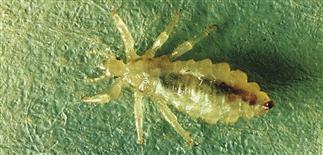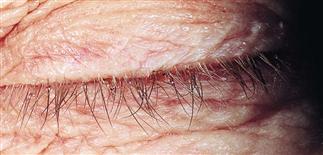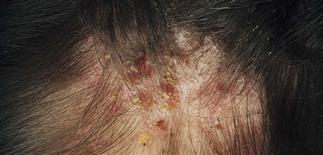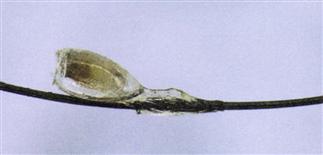93
Head lice (pediculosis)

Three kinds of lice with similar characteristics infest humans. Body lice are largest. They are wingless insects with three pairs of legs. Legs terminate in sharp claws adapted for feeding and grasping.

Infestations of the eyelash are seen almost exclusively in children. It may induce blepharitis with lid pruritus, scaling, crusting, and purulent discharge.

Head lice are most often found in the occipital areas. Nits are deposited on the shaft 1 cm above the scalp surface. Excoriated lesions may become crusted and infected.

Nits are lice eggs that appear as white, firmly attached bumps.
DESCRIPTION
Infestation of hair of scalp, body, pubic region by flattened, wingless lice insects. Variation in distance between hair shafts by region corresponds to type of lice infection. Pediculus humanus var. capitis causes head lice. Infestation by Pediculosis corporis, also called body lice. Infestation by Phthirus pubis: pubic lice. Lice attach to skin, feed on human blood. Lay eggs (nits) that attach to hair shaft about 1 cm above scalp, hatch in 8–10 days. Head lice is highly contagious. Direct contact is primary source of transmission. Head lice more common in children. Obligate human parasites; cannot survive on other animals or furniture. Does not carry any known human disease but can transmit epidemic typhus and relapsing fever. Feed on blood every 3–6 h. Females lay 7–10 eggs a day, live for about 1 month.
HISTORY
• Typically diagnosed by schoolteacher or school nurse. • Fomite transmission via hats, brushes, earphones is common. • Symptoms range from itching of the neck to no symptoms. Posterior cervical adenopathy occasionally noted. • Infestation rare in African-Americans. • Infestation of eyelashes seen almost exclusively in children.
PHYSICAL FINDINGS
• Nits are small white eggs firmly cemented to the hair. Nits are easier to visualize than lice. Head lice can be seen on the hair shafts and scalp. • Diagnosis usually not difficult but may require repeated examinations. • Head lice have an elongated body similar to body louse but smaller. • Secondary impetigo may present with yellow or honey-colored crusting with cervical adenopathy. • Lice may induce blepharitis with lid pruritus, scaling, crusting, purulent discharge.
TREATMENT
Standard topical treatment
• Permethrin rinse 1% (over-the-counter) often first-choice drug. Permethrin 5% (Elimite) administered for treatment failures. Leave on hair overnight under shower cap. • Lindane (Kwell) shampoo is alternative. Lindane-resistant lice have emerged. • Malathion lotion 0.5% (Ovide) rapidly pediculicidal and ovidicidal, and for resistance to other treatments. • Repeat all above treatments in 1 week, because younger lice may not be eradicated. A special nit comb also helpful in the week following treatment. • Treatment of all close family members controversial but often recommended.
Alternative therapies
• Petrolatum (Vaseline), mayonnaise, or pomades applied to scalp overnight under a shower cap smother lice. • As last resort, shaving scalp can be curative.
Oral treatments
• Ivermectin 200 mg/kg prescribed in a single oral dose and repeated in 10 days. Causes paralysis and death of the parasite. • It has selective activity against parasites but no systemic effects on mammals.







